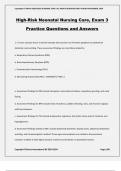Copyright © KAYLIN 2024/2025 ACADEMIC YEAR. ALL RIGHTS RESERVED FIRST PUBLISH NOVEMBER, 2024
High-Risk Neonatal Nursing Care, Exam 3
Practice Questions and Answers
2. A nurse assesses that a 3-day-old neonate who was born at 34 weeks' gestation has abdominal
distention and vomiting. These assessment findings are most likely related to:
a. Respiratory Distress Syndrome (RDS)
b. Bronchopulmonary Dysplasia (BPD)
c. Periventricular Hemorrhage (PVH)
d. Necrotizing Enterocolitis (NEC) - ANSWER✔✔-ANS: d
a. Assessment findings for RDS include tachypnea, intercostal retractions, respiratory grunting, and nasal
flaring.
b. Assessment findings for BPD include chest retractions; audible wheezing, rales, and rhonchi; hypoxia;
and bronchospasm.
c. Assessment findings for PVH include bradycardia, hypotonia, full and/or tense anterior fontanel, and
hyperglycemia.
d. Assessment findings related to NEC include abdominal distention, bloody stools, abdominal distention,
vomiting, and increased gastric residual. These signs and symptoms are related to the premature
neonate's inability to fully digest stomach contents and limitation in absorptive function.
Copyright ©Stuvia International BV 2010-2024 Page 1/60
,Copyright © KAYLIN 2024/2025 ACADEMIC YEAR. ALL RIGHTS RESERVED FIRST PUBLISH NOVEMBER, 2024
3. A full-term neonate who is 30 hours old has a bilirubin level of 10 mg/dL. The neonate has a yellowish
tint to the skin of the face. The mother is breastfeeding her newborn. The nurse caring for this neonate
would anticipate which of the following interventions?
a. Phototherapy
b. Feeding neonate every 2 to 3 hours
c. Switch from breastfeeding to bottle feeding
d. Assess red blood cell count - ANSWER✔✔-ANS: b
a. Phototherapy is considered when the levels are 12 mg/dL or higher when the neonate is 25 to 48
hours old. Neonates re-absorb increased amounts of unconjugated bilirubin in the intestines due to lack
of intestinal bacteria and decreased gastrointestinal motility.
b. Adequate hydration promotes excretion of bilirubin in the urine.
c. Colostrum acts as a laxative and assists in the passage of meconium.
d. Assessing RBC is not a treatment for hyperbilirubinemia.
5. A nursery nurse observes that a full-term AGA neonate has nasal congestion, hypertonia, and tremors
and is extremely irritable. Based on these observations, the nurse suspects which of the following?
a. Hypoglycemia
b. Hypercalcemia
c. Cold stress
d. Neonatal withdrawal - ANSWER✔✔-ANS: d
Copyright ©Stuvia International BV 2010-2024 Page 2/60
,Copyright © KAYLIN 2024/2025 ACADEMIC YEAR. ALL RIGHTS RESERVED FIRST PUBLISH NOVEMBER, 2024
a. Signs and symptoms of hypoglycemia are jitteriness, hypotonia, irritability, apnea, lethargy, and
temperature instability, but not nasal congestion.
b. Signs and symptoms of hypercalcemia are vomiting, constipation, and cardiac arrhythmias.
c. Signs and symptoms of cold stress are decreased temperature, cool skin, lethargy, pallor, tachypnea,
hypotonia, jitteriness, weak cry, and grunting.
d. These are common signs and symptoms of neonatal withdrawal.
6. The following four babies are in the neonatal nursery. Which of the babies should be seen by the
neonatologist as soon as possible?
a. 1-day-old, HR 170 bpm, crying
b. 2-day-old, T 98.9°F, slightly jaundice
c. 3-day-old, breastfeeding q 2 h, rooting
d. 4-day-old, RR 70 rpm, dusky coloring - ANSWER✔✔-ANS: d
a. A slight tachycardia—170 bpm—is normal when a baby is crying.
b. Slight jaundice on day 2 is within normal limits.
c. It is normal for a breastfed baby to feed every 2 hours.
d. A dusky skin color is abnormal in any neonate, whether or not the respiration rate is normal, although
this baby is also slightly tachypneic.
Copyright ©Stuvia International BV 2010-2024 Page 3/60
, Copyright © KAYLIN 2024/2025 ACADEMIC YEAR. ALL RIGHTS RESERVED FIRST PUBLISH NOVEMBER, 2024
9. It is noted that the amniotic fluid of a 42-week gestation baby, born 30 seconds ago, is thick and
green. Which of the following actions by the nurse is critical at this time?
a. Perform a gavage feeding immediately.
b. Assess the brachial pulse.
c. Assist a physician with intubation.
d. Stimulate the baby to cry. - ANSWER✔✔-ANS: c
a. This action is not appropriate. The baby needs tracheal suctioning.
b. The baby needs to have tracheal suctioning. The most important action to promote health for the
baby is for the health-care team to establish an airway that is free of meconium.
c. This action is appropriate. The baby needs to be intubated in order for deep suctioning to be
performed by the physician. A nurse would not intubate and suction but rather would assist with the
procedures.
d. It is strictly contraindicated to stimulate the baby to cry until the trachea has been suctioned. The
baby would aspirate the meconium-stained fluid, which could result in meconium-aspiration syndrome.
10. A 42-week gestation neonate is admitted to the NICU (neonatal intensive care unit). This neonate is
at risk for which complication?
a. Meconium aspiration syndrome
b. Failure to thrive
c. Necrotizing enterocolitis
Copyright ©Stuvia International BV 2010-2024 Page 4/60




